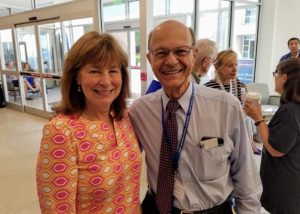
Leslie Chambers
President and CEO at the American Parkinson Disease Association (APDA)
In 2012, the Board of the American Parkinson Disease Association (APDA) retained DRG Search to conduct a search to find its next leader. DRG identified Leslie Chambers who was selected to succeed Mr. Joel Gerstel who had been APDA’s CEO since 1995 and had been associated with the organization for more than 25 years.
Before joining APDA, Chambers held leaderships positions with the Alzheimer’s Association, The Leukemia & Lymphoma Society, and Autism Speaks. Over five years into her tenure as CEO at APDA, she remains effusive about her role, “I am continually inspired and energized by the amazing people I have met over the past five years: patients, care-partners, researchers, physicians/healthcare providers, donors, volunteers and staff and I am motivated to work even harder at improving the quality of life for people with Parkinson’s and someday finding a cure for PD.”
In her interview with DRG, Chambers talks about the changes at APDA, how she stays inspired, and how she guides the organization.
- What are some of the values that guide your work and define your approach to leadership?
I focus on the strategic direction and goals of the organization and continually ask if the daily activities and energy/resources we’re expending are supporting those goals. It’s important to ask a lot of questions and to prioritize our efforts individually and collectively. When leading a nonprofit, there is a tendency to always say ”yes” to a new initiative or a request to help our constituents, so it’s important to understand where we will have the biggest impact with the work that we do. Sometimes the right thing to do is to say no to a new program so that our staff can remain focused on the initiatives that will have the greatest impact in the Parkinson’s community.
I am a consensus builder and take in a wide range of perspectives and opinions when making many decisions. However, I also make quick decisions when necessary; inaction on the part of a leader is the quickest way to erode confidence and trust in an organization.
Transparency is paramount in everything that we do at APDA. I often remind folks that many of our donors are elderly individuals living on fixed incomes and we need to ensure that every donation, whether it is $20 or $200,000, is handled with care and invested in the most efficient and impactful manner. We continually strive to be outstanding stewards of the public’s trust and financial support. I would say that the one personal trait most important to me in my role as a leader is to have respect for all.

- What was your perception of the organization before joining APDA and how has it changed over time?
Prior to joining APDA, I did not know much about Parkinson’s disease nor the various organizations in the Parkinson’s community. During my learning process throughout the CEO search, my observations were that the organization had a strong family legacy and I was amazed to learn that the founding members were not directly affected by the disease. I was so impressed that the organization was founded on the principles of what I call “true American philanthropy”! This was very different from any other national voluntary health agency I had encountered in the past and something I am very proud to share as I explain the history of the organization to others. I believe that the organization has grown and matured over the last five years through the creation and implementation of its first strategic plan and that it has evolved into a much more united, impactful, patient-centric organization. We have raised significantly more funding which has enabled us to deliver many more meaningful patient services and programs, fund significantly more research grants, and increase our overall organizational capacity and effectiveness at both the national and local levels.
- What was the first thing you did when you joined as President & CEO?
I worked with the lead VP and created a staff questionnaire which was completed anonymously by the home office staff. The answers were aggregated and given to me in preparation for a face-to-face meeting with the entire staff as a group. This was followed by one-on-one meetings with individual staff members. During the meetings I spent most of the time listening and learning from each person about their history with APDA, what their current jobs entailed, what they thought about current problems/issues as well as what was working well, and where they felt the organization was headed.
I also met one-on-one with the Executive Committee members of the Board as I prepared my first budget and annual plan of operations within the first 3 weeks in my new role with APDA.
- How are you working with the Board to develop new initiatives that would give APDA an edge into the latest technology to help people living with Parkinson’s disease?
This has been accomplished by leading the development of the organization’s first strategic plan (we are now in the process of creating our second 3 year plan beginning in 2019) which focuses on increasing the funding to expand our patient services and research programs. Included in these two components of our mission are an entire webinar series focused on the latest treatments, interventions and services in the field of Parkinson’s care and where to find outstanding resources in local communities which will improve the overall quality of life for the person with Parkinson’s disease (and their care partners).
In addition, our research program focuses on funding projects in three areas: 1. Neuroprotection, 2. Biomarkers 3. Novel therapies. Within the novel therapies’ category, we are funding many projects focused on the latest technology in Parkinson’s science including: wearable technology to evaluate and improve gait, balance, walking and postural instability issues and deep brain stimulation and techniques in the lab designed to improve the research process.
- Tell us about a new initiative at APDA and what you envision it will do for the community suffering from Parkinson’s (and or their families/caretakers)?
We are in the process of creating our second Public Service Awareness Campaign (PSA) which is focused on empowering individuals with PD and highlights all the things a person with this disease can still achieve and accomplish while battling this chronic neurologic condition. The goal of the campaign is to increase public awareness about the disease and about how APDA is here to support those affected by Parkinson’s.
About the American Parkinson Disease Association: The American Parkinson Disease Association (APDA) is the largest grassroots network dedicated to fighting Parkinson’s disease (PD) and works tirelessly to assist the more than 1 million Americans with PD live life to the fullest in the face of this chronic, neurological disorder. Founded in 1961, APDA has raised and invested more than $177 million to provide outstanding patient services and educational programs, elevate public awareness about the disease, and support research designed to unlock the mysteries of PD and ultimately put an end to this disease.
